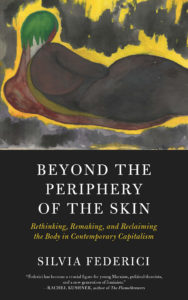
[PM Press; 2020]
Silvia Federici’s Beyond the Periphery of the Skin: Rethinking, Remaking, and Reclaiming the Body in Contemporary Capitalism is a baffling work that slides from the academically indefensible to the ethically dubious with remarkable facility.
Before getting into that, I want to make clear this was not something I expected or was at all pleased about. If it’s true that people actually enjoy writing scathing reviews, I am not one of them (at any rate, I’ve only really done it once). In fact I initially requested to review it partially for the opportunity to reread the author’s previous work, Caliban and the Witch: Women, the Body, and Primitive Accumulation, having been given to understand that Beyond the Periphery of the Skin is an addendum to the themes explored in that groundbreaking work. Caliban and the Witch is a history of the mechanization of the body under capitalism, and more specifically a feminist and historical materialist analysis of how the origins of capitalist accumulation and the subjugation of women are inextricably linked. From the state-sanctioned sex trafficking of proletarian women in response to the post-Black Death wage boom, to the forcible expropriation of women’s industries and fields of knowledge during the enclosure movement, to the brutal population-growth measures of early capitalist states that aimed at breaking the control of women over their own reproduction, Federici shows in painstaking detail the process through which “in the new capitalist regime women themselves became the commons, as their work was defined as a natural resource, laying outside the sphere of market relations” (97). The book demonstrates how these political struggles over women’s bodies, baked into the pre- and early history of capitalist production, were in turn hypostasized in religion and culture, taking on their own ideological life such that they continue to color the terms of contemporary debates over the naturalization and devaluation of women’s labor and reproductive autonomy.
Caliban and the Witch is a masterpiece. It is audacious, rigorous, and wildly compelling in its unrelenting demolition of what we have been conditioned to think of as “natural,” particularly when it comes to women and women’s body-politics.
In many ways, Beyond the Periphery of the Skin represents a reversal of the critical position of Caliban and the Witch. From the start, Federici makes clear that she believes contemporary feminism has gone too far in its de-naturalization of the concept, and the physical bodies and practices traditionally associated with the concept, of “women.” Under the guise of attacking postmodern theories that have supposedly supplanted political and historical criticism, Beyond the Periphery of the Skin is somewhat counterintuitively named, as it in essence calls for a rearticulation of what its author construes as formerly stable boundaries around female gender, the female body in general, and motherhood.
The dastardly forces blurring women’s boundaries, for Federici, largely coalesce into two fronts: first, “poststructuralist theories postulating that bodies and genders are the products of discursive practices and performance” (2) and second, the “body-remake movement” which she says “rang[es] from plastic surgery to surrogacy and gender reassignment” and which she claims betrays an uncritical “dependence on [the medical institution] that has a long history of cooperation with capital and the state” (4). To prevent myself from writing something as long as Beyond the Periphery of the Skin itself, I will limit this review to conveying a sense of the portion of the book that contains the meat of its attempt at a critical intervention in contemporary feminist debates: namely, Part Two, composed of three chapters entitled “On the Body, Gender, and Performance,” “Remaking Our Bodies, Remaking the World?” and “Surrogate Motherhood: A Gift of Life or Maternity Denied?”
The focal point of the first of these chapters, and the first of Federici’s two netherworldly bugbears, is what she glosses as “performance theory.” While admitting that the concept of “performance helps us to denaturalize ‘femininity’” (47), Federici argues that it uncritically situates the identity “woman” as at best an act of consent and at worst the product of individual caprice, rather than “an identity that is collective and embraced through a process of struggle,” a definition which Federici associates with the feminism of the seventies (48). Essentially, the old chestnut is that the identity of “woman” has lately been evacuated of its historical content as well as its unifying force, a well-worn line of attack for critics of contemporary feminism (and, incidentally, one that is formally isomorphic with much right-wing anti-feminism in general).
However, the reader eager to know what exactly Federici understands by “performance theory,” or who its supporters are who, according to the author, demand that we must relegate to oblivion any discussion or appreciation of the “material/physiological aspect of our bodies” (50) will be repeatedly frustrated. While the strident condemnation of the notion of gender as “a product of performance” permeates the chapter and indeed the book, “performance theory” as such is never explained and its supposed proponents are never substantively engaged with — in fact, nothing and nobody is even quoted on the subject. As is disturbingly common among late-career academic superstars (see my review of Terry Eagleton’s Radical Sacrifice, also in Full Stop), the enemy is everywhere and nowhere: “My reference,” Federici says herself, “is less to the theory of performance articulated, for example, by Judith Butler, at least in her later works, than to the popular version of it circulating among feminists” (49). While reading this chapter, I found myself thinking that if I were grading it as an undergraduate essay, I would be compelled to write “straw man” in the margin and demand its author include at least some actual reference to some actual texts. Most often, writers who argue this way do not reference anything because they haven’t done the necessary reading, they think they already know enough about the subject not to have to do the reading, or there actually isn’t anybody who really argues the things they are so vociferously condemning in the first place.
As it stands, the only real person apart from Michel Foucault who Beyond the Periphery of the Skin references as a source of the pernicious postmodernism we must take up arms against is Judith Butler. Not quite coincidentally, I think, this kind of straw-manning turns out to be eerily common among Butler’s most implacable critics: so much so, in fact, that Butler wrote an entire book, tellingly entitled Bodies that Matter,about misreadings (or non-readings) of Gender Trouble, and specifically its articulation of gender performativity and bodily materiality. Federici might have found herself agreeing with Butler more than she would like to admit had this book entered somewhere into her vague account of “performance theory”: in Bodies That Matter, in fact, Butler makes clear that she never had any interest in arguing that “the materiality of bodies is simply and only a linguistic effect which is reducible to a set of signifiers,” in part because “such a distinction overlooks the materiality of the signifier itself” (6). In the preface to Bodies That Matter Butler even parodically prefigures the very style of argument Federici marshals against the nebulous “performance theorists” who haunt the margins of Beyond the Periphery of the Skin:
[P]erhaps someone forgot to teach me “the facts of life”? Was I lost to my own imaginary musings as that vital conversation was taking place? And if I persisted in this notion that bodies were in some way constructed, perhaps I really thought that words alone had the power to craft bodies from their own linguistic substance?
Couldn’t someone simply take me aside?
Matters have been made even worse, if not more remote, by the questions raised by the notion of gender performativity introduced in Gender Trouble. For if I were to argue that genders are performative, that could mean that I thought that one woke in the morning, perused the closet or some more open space for the gender of choice, donned that gender for the day, and then restored the garment to its place at night. (ix)
More interestingly, if somewhat less funnily, Butler also presents a simple argument to counter the popular straw-man so often made of her work:
Such a willful and instrumental subject, one who decides on its gender, is clearly not its gender from the start and fails to realize that its existence is already decided by gender. Certainly, such a theory would restore a figure of a choosing subject — humanist — at the center of a project whose emphasis on construction seems to be quite opposed to such a notion. (ix)
What follows from this point is an entire book about the political, historical, and cultural lines of force that go into constructing what we understand by gender, and specifically its intimate (if exceedingly complex and often not-entirely-symmetrical) relationship to the “material/physiological aspect of our bodies” that Federici argues is so sorely lacking in the Butlerian strain of contemporary feminism. This basic non-engagement with the actual ideas that her latest work militates against begins to reveal its true character in the closing paragraphs of the chapter “On the Body, Gender, and Performance,” where Federici actually writes the following words:
Paradoxically, a testimony to the relevance of difference in our experience of our physical makeup comes from a large section of the trans movement that is strongly committed to a constructivist view of gender identities, as many undergo costly and dangerous surgeries and medical treatments in order to transition to a different gender. (50)
This jaw-droppingly feeble and tired gotcha, directed at some “large section” of “the trans movement,” begins to reveal the nature of the bone Federici has really come to pick. At this point, that is, the reader realizes the Beyond the Periphery of the Skin is not interested in the critique of patriarchal systems of oppression, but rather in attacking those people who its author appears to see as complicit in those systems via the erosion of the definition of “women” as it was understood in the feminism of the seventies. In so many words, these are largely gender-nonconforming people, trans people, and people who engage in surrogacy.
The next chapter, accordingly, sets its sights on “body remakes,” a blanket-definition covering practices as disparate as tattooing and bodybuilding to plastic surgery and gender affirmation surgery. First identifying the present “craze for remakes” (55) with the “acceptance of an aesthetic discipline that in the 1970s we rejected,” Federici nostalgically looks back to a time when “we saw each other as beautiful because we were defiant, because in freeing ourselves from the prescriptions of a misogynous society we explored new ways of being, new ways of laughing, hugging, wearing our hair, crossing our legs, new ways of being together and making love” (56). The chapter goes on to further identify “body remakes” not only with enslavement to oppressive aesthetic ideals, but also unthinking acceptance of “the medical profession [as] the godlike creators [sic] of our bodies” (59). Admittedly, most direct reference to transgender people is excised — perhaps the work of a judicious editor, who may have recognized that Federici’s assertion that “Dr. Frankenstein’s dream is back on the table” (59) would almost certainly turn very many trans and trans-allied readers off.
It is hard to know where to begin with this chapter — the fact, for example, that a central object of criticism in trans scholarship is the immutable, binary assignation of one’s gender at birth, by doctors, would seem to put to the lie the notion that trans people in general think that doctors are “the godlike creators of our bodies.” Federici additionally appears unwilling to consider the quite basic historical fact that trans peoples’ struggles have often been directed precisely against those medical institutions that would, and in many cases still do, deny them the validity of their very embodiment. These institutions include, for instance, the American Psychiatric Association, which categorized transgender identity as a mental disorder until 2017, after decades of pressure from trans activists and the work of trans scholars led to more broad-based acceptance and nuanced understanding of transgender identity and experience. Instead of going farther down this rabbit hole and trying to seriously engage with such an egregiously lazy piece of writing, instead, I will encourage the reader to look to the work of trans scholar and activist Susan Stryker, and particularly her essay, “My Words to Victor Frankenstein Above the Village of Chamounix: Performing Transgender Rage,” which directly confronts the “Frankenstein” slur often cast against trans people. I would additionally encourage the reader — and if I could, the author of Beyond the Periphery of the Skin — to also read Stryker’s monumental work, Transgender History, and particularly its chapter entitled “The Difficult Decades,” which traces the flourishing of trans-exclusionary feminism in the very seventies to which Federici so wistfully harks back.
If these two chapters weren’t enough to exhaust the even marginally critical reader, “Surrogate Motherhood: A Gift of Life or Maternity Denied?” offers yet another obstacle-course of dubious reasoning and regressive innuendo. This chapter begins (begins) from the dual premises that “surrogacy represents gestation as a purely mechanical process . . . in which the woman must have no emotional involvement” and that it further represents “the commodification of human life, as it is the organization and legitimation of a children’s market, and the definition of the child as a property that can be transferred, bought, and sold” (63). Aside from explaining how a gestating person’s “emotional involvement” can be mechanically regulated, Federici’s definition of surrogacy — like her definitions of “performance theory” and “body remakes” — is in desperate need of explanation and documentary support. Here as elsewhere, though, her vague and oracular pronouncements are simply posited as fact and then expounded upon as axioms. Thus, providing no proof and demonstrating no pursuable line of reasoning, Federici is able to further announce that there is “evidence” (which is not given) “that some surrogate children are channeled to the organ market, for once the transaction has taken place no institutional oversight checks what happens to the children marketed this way who in most cases are taken to other regions, thousands of miles away from their birth” (66). A paragraph later, she then declares that “seeing one’s mother turn over her newborn child to strangers may also have a traumatic impact on her other children, who fear that the same destiny will occur to them” (66), an absurd and deeply offensive idea that is as much a condemnation of adoption and even babysitting as it is a critique of surrogate motherhood. Federici goes on to cast children who are not raised by their birth-mothers as lacking or broken, and compares surrogate mothers to slaves (67) and also, bafflingly, slave-dealers (69). Mobilizing the work of black scholars critical of the racist and classist history of forced surrogate motherhood, Federici finally asserts a “profound racism inherent to the practice of surrogacy” in general and declares that “surrogacy is the epitome of the capitalist conception of social relations” (67), tokenizing black families as an idyllic counterpoint to this dystopian vision, as “they” (referring to black people in general) “have a different conception of parenting, developed out of a long history of enslavement and oppression, a conception in which all in the community are responsible for its children and all are sisters and brothers” (67-8).
As before, I struggle with where to begin. For one thing, confronting and dismantling the oppressive structures informing the contemporary institution of surrogacy is quite a different operation from condemning the practice in toto and likening anybody who engages with it to organ-harvesters and slave-dealers (but also slaves; but also not slaves . . .). It is indeed important to recognize that racist and capitalist value-structures have made it such that institutional surrogacy is primarily available to well-to-do white people, but one might reasonably expect a Marxist thinker to take this as the starting-point for an argument to decolonize and democratize the institution, while advocating for a more collective, de-privatized approach to gestation and child-rearing. This argument forms the foundation of Sophie Lewis’s recent work, Full Surrogacy Now!: Feminism Against Family, in which the author shows that “while there is no technological ‘fix’ to the violent predicament human gestators are in, . . .[f]undamentally, the whole world deserves to reap the benefits of already available techniques currently monopolized by capitalism’s elites.” Lewis invites her reader to envision a world in which “Another Surrogacy is Possible,” quite in contrast to Federici’s family-values approach, which at its core demands a return to traditional forms of motherhood. “Reclaiming the Body in Contemporary Capitalism” indeed.
I could go on, but frankly this book is exhausting. For such a slim volume, it is truly packed with bizarrerie — I didn’t even mention, for example, Federici’s preoccupation with brain-implants, the sudden appearance of “animal spirits,” repeated claims that humans have evolved over “billions of years,” the resurrection of “the myth of the vaginal orgasm,” and a number of other notions that seem more fit for a wacky relative’s Facebook post than a work of actual scholarship. And in fact, I wanted to end this review with at least some reference to what the book manages, despite itself, to do well: abstracted from its actual content to the highest possible degree, Beyond the Periphery of the Skin does at the very least encourage its audience to scrutinize what might go unquestioned or otherwise be taken for granted in contemporary feminist debates on gender, the body, and motherhood. When the book itself actually gets down to addressing what those assumptions are or attempts to intervene in those debates, though, it does far more than simply miss the mark, coming off as tone-deaf at its best and ethically egregious at its worst. And it is very often at its worst.
Instead of allowing this review-cum-polemic to trudge along any farther, I’ll simply reiterate my proposed reading list of works that the author of Beyond the Periphery of the Skin probably should have read before writing that book, and what the reader of this review should read before (or perhaps instead of) buying that book:
Judith Butler’s Bodies That Matter: On the Discursive Limits of Sex was published in 1993 by Routledge.
Susan Stryker’s “My Words to Victor Frankenstein Above the Village of Chamounix: Performing Transgender Rage” was published in 1994 by GLQ.
Stryker’s revised and updated second edition of Transgender History: The Roots of Today’s Revolution was published in 2017 by Hachette.
Sophie Lewis’s Full Surrogacy Now!: Feminism Against Family was published in 2019 by Verso.
Cory Austin Knudson is a graduate student in Comparative Literature and Literary Theory at the University of Pennsylvania. For him this mostly means writing about porn, Nietzsche, and climate change, and trying to prove how intimately related those three really are.
This post may contain affiliate links.







